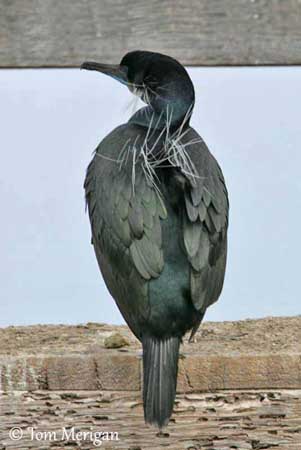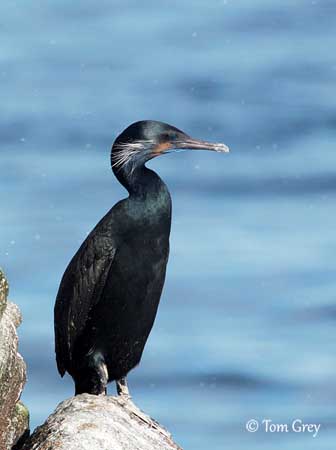
Fr: Cormoran de Brandt
All : Pinselscharbe
Esp : Cormorán Sargento
Ital : Cormorano di Brandt
Nd: Brandts Aalscholver
Sd: Blåstrupig skarv
Photographers:
Tom Grey
Tom Grey's Bird Pictures
Tom Merigan
Tom Merigan’s Photo Galleries
Text by Nicole Bouglouan
Sources:
HANDBOOK OF THE BIRDS OF THE WORLD vol 1 by Josep del Hoyo-Andrew Elliot-Jordi Sargatal - Lynx Edicions - ISBN: 8487334105
FIELD GUIDE TO THE BIRDS OF NORTH AMERICA - National Geographic Society - ISBN: 0792274512
BirdLife International (BirdLife International)
All About Birds (Cornell Lab of Ornithology)
National Park Service – Channel Islands
What Bird-The ultimate Bird Guide (Mitchell Waite)
Brandt’s Cormorant
Phalacrocorax penicillatus
Suliformes Order – Phalacrocoracidae Family
BIOMETRICS:
Length: 84-89 cm
Wingspan: 124 cm
Weight: 2450 g
DESCRIPTION:
This species has been described by the German naturalist Johann Friedrich von Brandt during the early 19th century.
The adult male in breeding plumage is glossy black with green iridescence, and shows fine white feathers on head sides, neck and back. The throat is cobalt-blue, bordered below by a whitish crescent. The blue colour fades quickly after the breeding season.
The bill is blackish with hooked tip. The eyes are bright turquoise. The short legs and the webbed feet are black.
This bird has long neck and body.

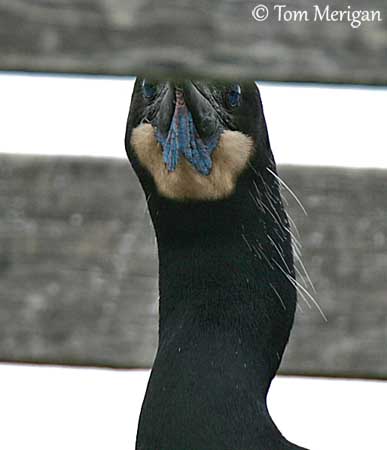
The female has similar plumage but she is smaller.
In non-breeding plumage, the adults lack the fine white feathers on head sides, neck and back. The throat is much duller and lacks the blue tinge.
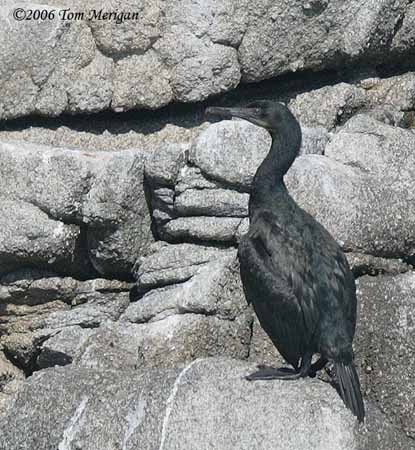
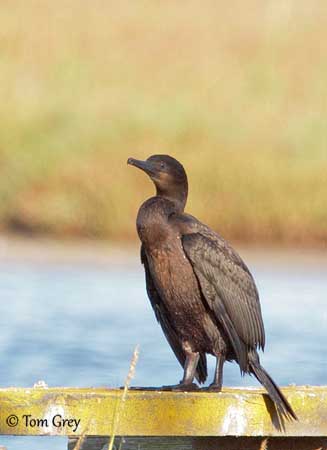
VOICE: SOUNDS BY XENO-CANTO
The Brandt’s Cormorant is noisy during the nesting period and at nest. It utters a variety of croaks and grunts. Usually, the male is more vocal than the female. She only produces soft sounds and is often largely silent.
HABITAT:
The Brandt’s Cormorant has marine behaviour. It frequents the rocky coastal shores and during winter, it can be found in sheltered waters and bays.
This species roosts on rocks, islands and sandy beaches.
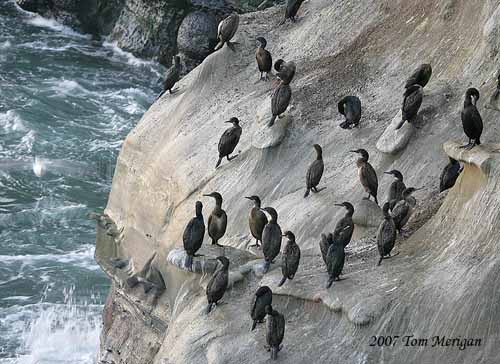
RANGE:
The Brandt’s Cormorant is found on the W coasts of North America, from SE Alaska to Baja California (Mexico).
BEHAVIOUR:
The Brandt’s Cormorant usually forages over rocky substrate and over sand or mud, and in mid-water too.
It feeds by pursuit-diving, swimming underwater with the wings while the webbed feet propel its body. It catches the prey with its hooked bill and feeds mainly on fish of numerous species. It can dive very deeply and can reach 100 metres in depth.
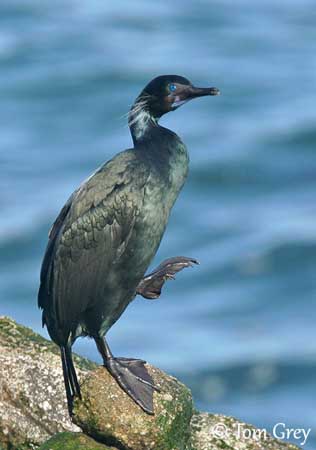
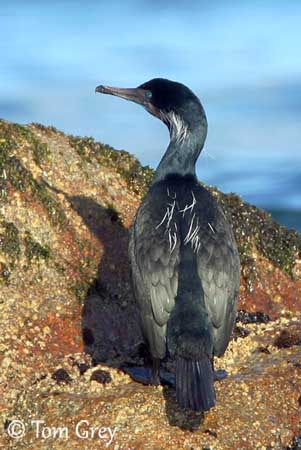
This species may sometimes perform co-operative fishing by forming large mobile groups. They swim and dive in unison in order to gather the shoals of fish. They catch their preys at the same time.
This species is gregarious outside the breeding season.
Like other cormorants, the Brandt’s Cormorant often spreads its wings out, in order to dry them after foraging underwater. The feathers are soaked and the bird cannot take flight.
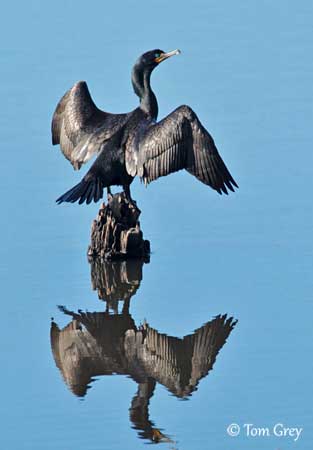
At the beginning of the breeding season, the male selects a site for the nest where it displays. The blue throat is inflated while head and tail are pointed skywards. They breed in colonies, sometimes with other seabirds or other cormorants.
The male displays to attract a female. When one female lands close to the male and if she is accepted, displays end. The male brings nest materials to the female which builds the nest.
Copulation takes place at the nest-site, and both mates defend the small territory around the nest. Threat displays can be performed if an intruder approaches the nest. Males may fight together.
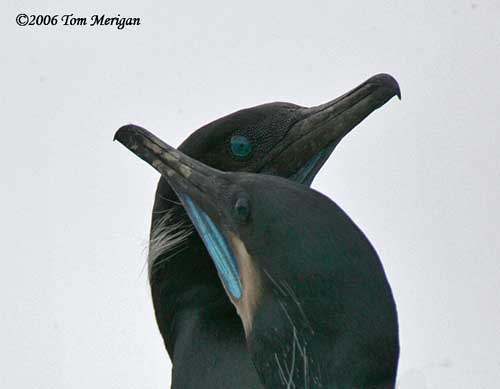
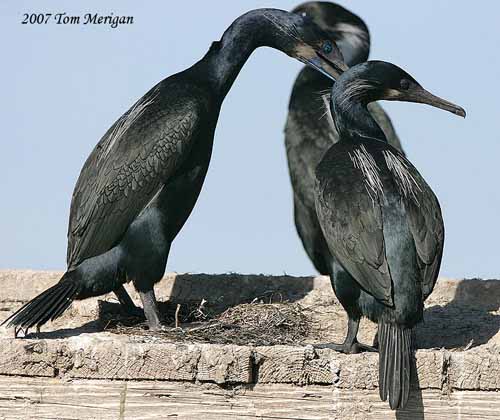
This species is sedentary in its range. Some dispersal may occur in autumn.
FLIGHT:
The Brandt’s Cormorant flies usually low over water in order to watch for preys. But a flying flock may fly in long line between feeding and roosting areas.
REPRODUCTION:
The breeding season occurs between March and July.
The Brandt’s Cormorant breeds in colonies with other seabirds. The nest is made with seaweeds, grass, moss and debris brought by the male. All materials are stuck together with droppings. They may sometimes reuse the same nest.
The nest-site takes place on the ground on slopes, at cliff top or on rocky outcrops.
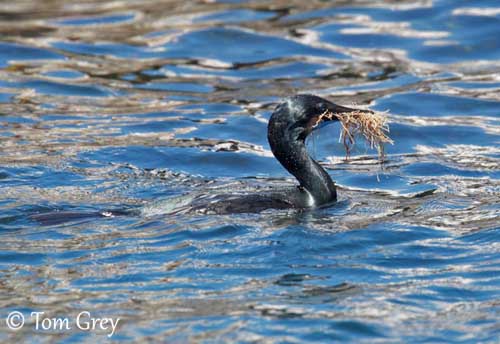
The female lays 2-5 pale blue eggs. At hatching, the chicks are naked and helpless. They are fed by both parents by regurgitation. The adults brood them to keep them warm, and provide them shade in hot weather.
The chicks often congregate in crèches, but they return to their own nest to be fed. They can breed at about two years old.
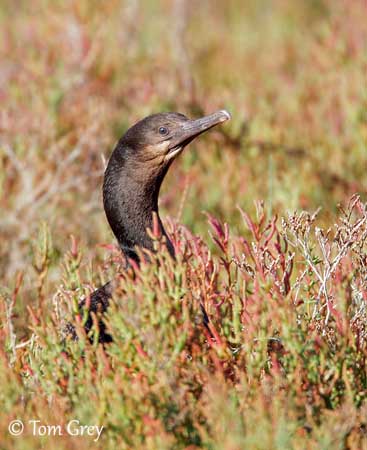
DIET:
The Brandt’s Cormorant feeds on wide variety of fish, and also consumes shrimps and crabs. It feeds by plunge-diving and pursues the preys underwater.
PROTECTION / THREATS / STATUS:
The Brandt’s Cormorant is common in its range and its populations appear stable.
El Niño may involve breeding failure and mortality. But currently, this species is not threatened.
